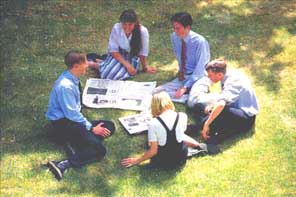In 1980, Bristol Cathedral School was one of the
first boys-only schools in the UK to begin admitting
girls in its sixth form, ending a male-only tradition
stretching back some 800 years. The decision to extend
the age for girls down to Year 7 is a logical extension
of that change, Mr Riley explains.
 “Here at BCS, we are of course well known for
our expertise in music and the arts, but in fact we
pride ourselves on getting the best out of children,
whatever they are good at. Now for the first time we
will be able to offer that to younger girls as well
as boys. “Here at BCS, we are of course well known for
our expertise in music and the arts, but in fact we
pride ourselves on getting the best out of children,
whatever they are good at. Now for the first time we
will be able to offer that to younger girls as well
as boys.
“We will be building on the really successful
experience of our sixth-form girls, many of whom have
told us they wished they could have come here when
they were younger,” Mr Riley said. “An 11-18 co-educational school offers opportunities
to develop fully rounded individuals, while maintaining
academic rigour. If you get it right, the co-ed school
can offer something better than either boys or girls
would have received if they had been educated in single-sex
schools.” Mr Riley also outlined what the change to co-education
will mean for Bristol ’s independent education
sector: “Our analysis indicates that we will
be meeting a real local need with the change to co-education.
Currently in central Bristol , there are single-sex
schools, a very big independent grammar school and
a traditional, large public school, but there is nothing
in the independent sector for parents wanting a family-orientated,
co-educational school of around 500 pupils.” “Boys and girls have to mix with each other
both in higher education and the world of work, so
it makes sense to prepare them for that while they
are at school,” added Mr Riley. “Parents
recognise this and so increasingly they expect their
children to be educated in a co-educational environment.
To be honest, when even schools such as Downside are
going co-educational, it is clear which way the future
lies.” The decision has also been welcomed by the Chairman
of Governors, Mr Stephen Parsons: “Co-education
throughout Bristol Cathedral School is entirely appropriate
in the 21 st century. It builds upon the strong foundation
of a school which has been a t the centre of music and
art in Bristol for several centuries.” t the centre of music and
art in Bristol for several centuries.” Mr Riley added that the move to co-education at Bristol
Cathedral School was not a snap decision – the
groundwork has been underway for some years. When Mr
Riley arrived at the school in the early 1990s, there
were only three female teachers: now 14 out of the
39 staff are women, and this number continues to increase. A staff working party including the Head of Girls,
Miss Kate Welham, has been established to prepare for
welcoming girls into Year 7 and above from September
2006. A female member of staff will be appointed to
the Senior Management Team and a female PE teacher
will also be appointed. Bristol Cathedral School traces its beginnings back
to the foundation of St Augustine ’s Abbey in
1140, after which monks gave an education to local
boys. It was re-founded as a Grammar School in 1542
following Henry VIII’s Dissolution of the Monasteries. |



 “Here at BCS, we are of course well known for
our expertise in music and the arts, but in fact we
pride ourselves on getting the best out of children,
whatever they are good at. Now for the first time we
will be able to offer that to younger girls as well
as boys.
“Here at BCS, we are of course well known for
our expertise in music and the arts, but in fact we
pride ourselves on getting the best out of children,
whatever they are good at. Now for the first time we
will be able to offer that to younger girls as well
as boys.  t the centre of music and
art in Bristol for several centuries.”
t the centre of music and
art in Bristol for several centuries.”